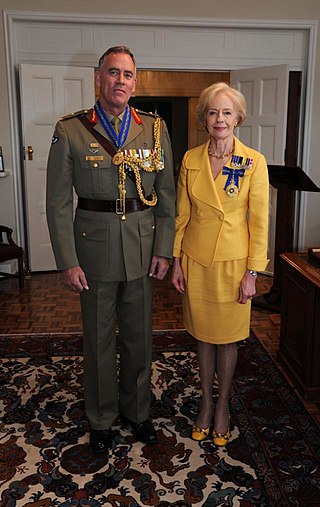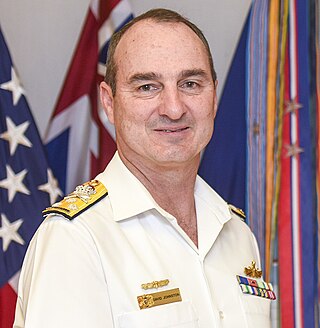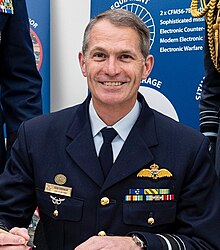
The Australian Defence Force (ADF) is the military organisation responsible for the defence of the Commonwealth of Australia and its national interests. It has three branches: the Royal Australian Navy (RAN), Australian Army and the Royal Australian Air Force (RAAF). The ADF has a strength of just over 89,000 personnel and is supported by the Department of Defence alongside other civilian entities.
The Defence Strategic Policy and Intelligence Group (SP&I) of the Australian Government Department of Defence is responsible for defence diplomacy, strategic policy, international security, and military intelligence co-ordination and advice to the Prime Minister of Australia, Minister for Defence, Secretary of the Department of Defence, and Chief of the Defence Force. The Defence Strategic Policy and Intelligence Group is led by the Deputy Secretary for Strategic Policy and Intelligence and comprises three policy divisions and two intelligence agencies.

The United Kingdom's Strategic Command (StratCom), previously known as Joint Forces Command (JFC), manages allocated joint capabilities from the three armed services.
The Royal Australian Air Force is organised into a number of operational, support and training formations located at bases across Australia.

The Chief of the Defence Force (CDF) is the highest-ranking and most senior military officer in the Australian Defence Force (ADF) and is the principal military advisor to the National Security Committee and the Minister for Defence. The current Chief of the Defence Force is Admiral David Johnston, who took office on 10 July 2024.
Defence Australia is a department of the Government of Australia charged with the responsibility to defend Australia and its national interests. Along with the Australian Defence Force (ADF), it forms part of the Australian Defence Organisation (ADO) and is accountable to the Commonwealth Parliament, on behalf of the Australian people, for the efficiency and effectiveness with which it carries out the Government's defence policy.
The Australian Defence Organisation (ADO) is an Australian Government organisation that consists of the Australian Defence Force (ADF), the Department of Defence, and other related organisations. In present use, the ADO is referred to as Defence. Defence's mission and purpose is "to defend Australia and its national interests in order to advance Australia’s security and prosperity".

General John Stuart Baker was a senior Australian Army officer. Entering the Royal Military College, Duntroon in 1954, his career culminated with his appointment as Chief of the Defence Force from 1995 to 1998, the most senior position in the Australian Defence Force. Baker also served as the inaugural Director of the Defence Intelligence Organisation from 1990 to 1992, Vice Chief of the Defence Force from 1992 to 1995, and was author of the highly influential 1988 "Baker Report".
Headquarters Joint Operations Command (HQJOC) is the Australian Defence Force's (ADF) operational-level headquarters responsible for the command and control of ADF operations worldwide. It was formed from "Headquarters Australian Theatre" (HQAST) in 2004 to reflect the changing internal structure of the ADF and the need to establish a purpose-built, co-located joint headquarters. Since December 2008, it has been based in NSW adjacent to the Kowen district of the Australian Capital Territory. The complex is known as the General John Baker Complex, named after a former Chief of Defence Force who was a strong advocate of joint command and control.

Major General Timothy Joseph McOwan, is a retired senior officer of the Australian Army. He served as Special Operations Commander Australia from February 2008 until January 2011, and the Australian Defence Attaché and Head Australian Defence Staff in Washington, D.C. He retired from the army in 2014.
The Chief of Joint Operations (CJOPS) is a three-star role within the Australian Defence Force (ADF), responsible for the Joint Operations Command and joint operational deployments, such as United Nations peacekeeping and joint task groups. Until 2007, the Vice Chief of the Defence Force (VCDF) was double hatted, additionally exercising the responsibilities of CJOPS. However, in September 2007 the Minister of Defence, Brendan Nelson announced the formation of a separate CJOPS position based at the Headquarters Joint Operations Command (HQJOC) at Bungendore, New South Wales.

Air Chief Marshal Mark Donald Binskin, is a senior officer in the Royal Australian Air Force Reserve. He served as Chief of Air Force (2008–11), Vice Chief of the Defence Force (2011–14), and Chief of the Defence Force from June 2014 until his retirement in July 2018. In February 2020 he was appointed as a Commissioner and Chairman of the Royal Commission into National Natural Disaster Arrangements. He is the current chair of the Civil Aviation Safety Authority of Australia.
The Australian Defence Organisation (ADO) is composed of the armed forces of the Commonwealth of Australia, the Australian Defence Force (ADF), and the Australian Public Service government department, the Department of Defence which is composed of a range of civilian support organisations.

The Australian Defence Force Investigative Service (ADFIS) is the unified investigative arm of the Australian Defence Force's Joint Military Police Unit. Initially formed in 2007 as a part of the service police until its amalgamation into the Joint Military Police Force at the beginning of 2020. ADFIS was responsible for complex and major disciplinary and criminal investigations involving the Australian Defence Force (ADF), its assets, land, personnel and capability.
The Australian Defence Organisation (ADO) is composed of the armed forces of the Commonwealth of Australia, the Australian Defence Force (ADF), and the Australian Public Service government department, the Department of Defence which is composed of a range of civilian support organisations.

Admiral David Lance Johnston, is a senior officer in the Royal Australian Navy. He served as Deputy Commander Joint Task Force 633 on Operation Slipper in 2010, Commander Border Protection Command from 2011 to 2013 and, following promotion to vice admiral, was posted as Chief of Joint Operations from 2014 until 2018. Johnston was appointed Vice Chief of the Defence Force in July 2018. He was promoted to admiral and appointed Chief of the Defence Force on 10 July 2024.
The Chief of Joint Capabilities (CJC) is the head of the Joint Capabilities Group (JCG) in the Australian Department of Defence. The Joint Capabilities Group was raised on 1 July 2017 with the position created as a result, with the inaugural CJC being Air Marshal Warren McDonald. The current chief is Lieutenant General Susan Coyle, who was appointed to the position in July 2024.
The Joint Health Command (JHC) is responsible for the delivery of military medicine and joint healthcare services to Australian Defence Force (ADF) personnel, including military psychiatry and rehabilitation services. The JHC is also responsible for providing strategic health policy, the development of the health preparedness of ADF personnel for operations, and the coordination of health units for deployment in support of operations. JHC is led by the dual-hatted Commander Joint Health and Surgeon General of the ADF.

Air Marshal Robert Timothy Chipman, is a senior officer in the Royal Australian Air Force (RAAF). He joined the RAAF as an aeronautical engineer in 1989 and gained his pilot's wings in 1994. He has commanded No. 75 Squadron RAAF (2006–09), the Air and Space Operations Centre (2010–12), No. 81 Wing RAAF (2013–14) and Air Task Unit 630.1 (2014), and deployed to the Middle East on Operations Slipper and Okra. He served as the Australian Military Representative to NATO and the European Union from 2019 to 2021, Head Military Strategic Commitments from 2021 to 2022 and Chief of Air Force from 2022 to 2024. Chipman took over as the Vice Chief of the Defence Force on 9 July 2024.
The Chief of Personnel (CPERS) is a three-star role within the Australian Defence Force (ADF), responsible for all members of the Australian Defence Force. The Minister of Defence, Richard Marles announced the creation of the new command following the Defence Strategic Review. The Chiefs main responsibility comes with the "distinct aim of increasing the effectiveness, efficiency and cohesiveness of personnel management to achieve a more integrated ADF".





















